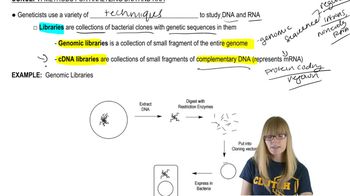Which of the following general transcription factors is responsible for binding to the TATA-Box
Table of contents
- 1. Introduction to Genetics51m
- 2. Mendel's Laws of Inheritance3h 37m
- 3. Extensions to Mendelian Inheritance2h 41m
- 4. Genetic Mapping and Linkage2h 28m
- 5. Genetics of Bacteria and Viruses1h 21m
- 6. Chromosomal Variation1h 48m
- 7. DNA and Chromosome Structure56m
- 8. DNA Replication1h 10m
- 9. Mitosis and Meiosis1h 34m
- 10. Transcription1h 0m
- 11. Translation58m
- 12. Gene Regulation in Prokaryotes1h 19m
- 13. Gene Regulation in Eukaryotes44m
- 14. Genetic Control of Development44m
- 15. Genomes and Genomics1h 50m
- 16. Transposable Elements47m
- 17. Mutation, Repair, and Recombination1h 6m
- 18. Molecular Genetic Tools19m
- 19. Cancer Genetics29m
- 20. Quantitative Genetics1h 26m
- 21. Population Genetics50m
- 22. Evolutionary Genetics29m
10. Transcription
Transcription in Eukaryotes
Problem 1c
Textbook Question
How do we know that eukaryotic transcription factors bind to DNA sequences at or near promoter regions?
 Verified step by step guidance
Verified step by step guidance1
Understand that eukaryotic transcription factors are proteins that regulate gene expression by binding to specific DNA sequences, often near promoter regions, to influence transcription initiation.
Recognize that experimental methods such as DNA footprinting and electrophoretic mobility shift assays (EMSAs) are used to identify where transcription factors bind on DNA. These techniques reveal protected or shifted DNA fragments indicating binding sites.
Consider chromatin immunoprecipitation (ChIP) assays, which use antibodies specific to transcription factors to pull down DNA-protein complexes from cells, followed by sequencing or PCR to identify the DNA sequences bound by the transcription factors in vivo.
Note that mutations or deletions in promoter regions that disrupt transcription factor binding sites often lead to changes in gene expression, providing functional evidence that these factors bind near promoters to regulate transcription.
Combine biochemical, genetic, and molecular biology evidence to conclude that transcription factors specifically bind to DNA sequences at or near promoter regions to control gene transcription.
 Verified video answer for a similar problem:
Verified video answer for a similar problem:This video solution was recommended by our tutors as helpful for the problem above
Video duration:
2mPlay a video:
Was this helpful?
Key Concepts
Here are the essential concepts you must grasp in order to answer the question correctly.
Transcription Factors and DNA Binding
Transcription factors are proteins that regulate gene expression by binding to specific DNA sequences near promoter regions. Their binding influences the recruitment of RNA polymerase and other transcription machinery, thereby controlling transcription initiation.
Recommended video:
Guided course

Prokaryotic Transcription
Promoter Regions in Eukaryotic Genes
Promoter regions are DNA sequences located upstream of a gene's coding region that serve as binding sites for transcription factors and RNA polymerase. These regions are crucial for initiating transcription and often contain specific motifs recognized by transcription factors.
Recommended video:
Guided course

Eukaryotic Transcription
Experimental Methods to Detect Protein-DNA Interactions
Techniques such as electrophoretic mobility shift assays (EMSAs), DNA footprinting, and chromatin immunoprecipitation (ChIP) are used to demonstrate transcription factor binding to DNA. These methods provide evidence of specific interactions at or near promoter regions in living cells.
Recommended video:
Guided course

Methods for Analyzing DNA and RNA

 9:16m
9:16mWatch next
Master Eukaryotic Transcription with a bite sized video explanation from Kylia
Start learningRelated Videos
Related Practice
Multiple Choice
734
views
1
rank
